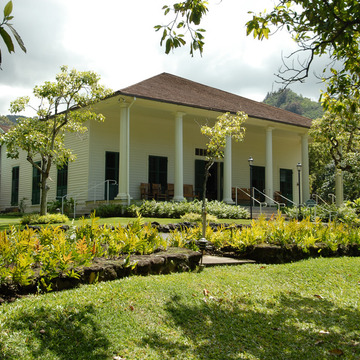Surrounded by rolling lawns, Queen Emma's summer palace stands as a white Greek temple with its colonnaded front lanai and shallow hipped roof. The clapboard-sided structure has a central hall and six rooms, with the front rooms each accessing the lanai through shuttered French doors. The house was built for the part-Hawaiian merchant John G. Lewis, the son of Captain Lewis and Polly Holmes. In 1850, he sold the property to John Young II, who, in turn, willed it to his niece Queen Emma in 1857.
Emma Kaleleonalani Rooke was born in 1836, the granddaughter of John Young, the British seaman who became a trusted advisor of Kamehameha I, and the great-granddaughter of Keliimaikai, the brother of Kamehameha I. She became queen of Hawaii in 1856 upon her marriage to King Kamehameha IV. After Queen Emma's death in 1885, the house was sold to the government in 1890. In 1911, the grounds were made into a park, and the house appeared destined for demolition until the Daughters of Hawaii intervened on its behalf. Four years later, the Daughters of Hawaii were given authority to maintain the house as a museum, which they do to this day.


